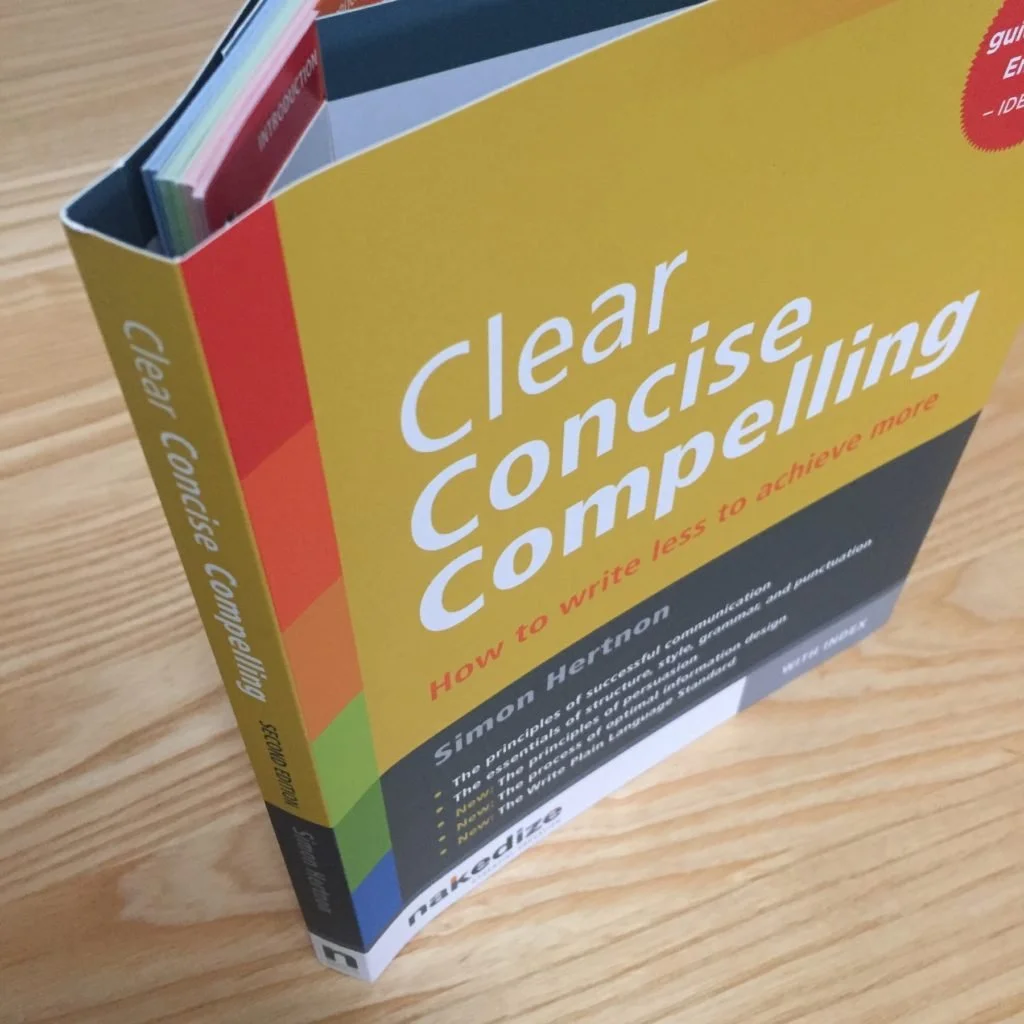Review of Clear Concise Compelling by Simon Hertnon
Clear Concise Compelling by Simon Hertnon
This is a well-named book. It’s clear, concise, and compelling: three themes that underpin Simon Hertnon’s advice on writing at work.
This is the first writing guide I’ve read that starts with the purpose of communication, then narrows down to communication at work, then again to writing at work. It seems obvious now that I’ve read it, but this is unique in the world of writing guides.
The first chapters focus on communication, then writing skills, and the later chapters offer reference materials you can return to as needed.
Here’s my review.
Communicating has a cost
Does it need to be written?
Is writing the best way to do this piece of business?
What useful questions!
You know how they say common sense isn’t that common? Simon shows us the obvious: that it takes time to write. If it takes time, it has a cost: our salary, the opportunity to do other things, and the effort and time (therefore salary) of our readers.
‘We need to rethink the costly habit of as-it-comes business writing.’
How many times have you written something that was never read?
It’s happened to me over and over again. I remember one time a boss asked me for a report on an aspect of our business. I produced a 6-pager for her, in plain language, as thorough and useful as I could make it.
We met to discuss it. As the first words came out of her mouth, my heart dropped. She hadn’t read it. I could tell instantly. I was disappointed – and furious.
‘Why did I spend all that time producing what you asked for if you didn’t even read it?’ I didn’t say that out loud, but my goodness, I felt it.
Then I became a manager. The idea of reading 6 pages of anything was beyond me. My life was a whirlwind of meetings, training, looking after my team members, and putting out fires.
It wasn’t until that moment I realised my boss couldn’t have coped with 6 pages. She might have read half a page. Or she might have preferred me to tell her my opinion in the meeting. But she asked for a report because she wanted me to think deeply about the topic and come to her with some effective solutions.
Simon’s book touches on both these issues. He describes it as:
commissioning: making sure my boss asked for what she actually wanted – in this case, some deep thinking and some recommendations
information design: creating ‘whatever information is needed for the solutions to be enacted’. In my case, it would have been either a half-page summary before our meeting, or a couple of great soundbites once I was face to face with her.
Every time we write an email that isn’t replied to, we’ve wasted our time. (Unless we learn how to communicate better next time…!) Every time we write a webpage that isn’t visited, a consultation document that doesn’t get enough replies… you get the idea.
Simon suggests we stop before we start, and check that:
writing is the best way to get the job done
we have a clear brief so we know exactly what the job is that we’re doing.
Safe to say the first two chapters blew my mind.
Plan, write, edit
Simon’s writing process is a model of best practice. Once you have a clear brief and you know a document is the best solution … plan, write, and edit.
Solid, sensible. No notes.
Structure and style
His chapter on structure and style took me a minute to get my head around – mostly because I’m not used to thinking of them as a set.
This chapter covers document structure, visual design, tone (created by style choices), and some psychology: why we find it so hard to choose simplicity and brevity. It ends with Write’s Plain Language Standard as a practical summary people can use to implement the ideas.
Simon has the gift of practising what he preaches. These are short sections full of strong, evidence-based advice.
As an ex-Write Ltd staff member, I was delighted to see an old friend, Write's MADE structure, feature in this section:
Main message
Action
Detail
Extra information.
It's a practical way to apply the inverted-pyramid structure that works well for busy readers.
Words, punctuation, and tips
Simon’s final chapters are a great reminder of the building blocks of effective sentences. If you feel shaky on grammar and punctuation, he’ll sort that out in a few tight pages. This is worth a read even if you’re an experienced writer.
Heard of a false subject but not sure what it is? He’ll explain.
Want to know how marketers make people excited to buy something they didn’t know they wanted? He’s got the scoop.
My biggest lessons from reading this book
Don’t start until you know writing is the best way to achieve your communication goal.
Focus every choice on your goal and your reader.
Assume your reader is busy and prefers short, clear writing.
Accuracy in word choice, grammar, and punctuation makes your writing more compelling.
Integrating these lessons into my work
As a trainer, I tend to focus on making the biggest improvements I can to people’s common writing problems. My clients buy 1- or 2-day workshops focused on writing a particular type of document. I’m supposed to make them better at emails, or board papers, or procedure docs.
As a result, I’ve lost focus on details like grammar and punctuation. It’s also never occurred to me to start a workshop by asking ‘Should this be written at all?’
Simon’s book has reminded me of the value of the big picture and the tiny details. I’ve been focusing on the stuff in between. Clear Concise Compelling reminds me that it’s all important: it’s all part of the picture of what makes writing excellent.

